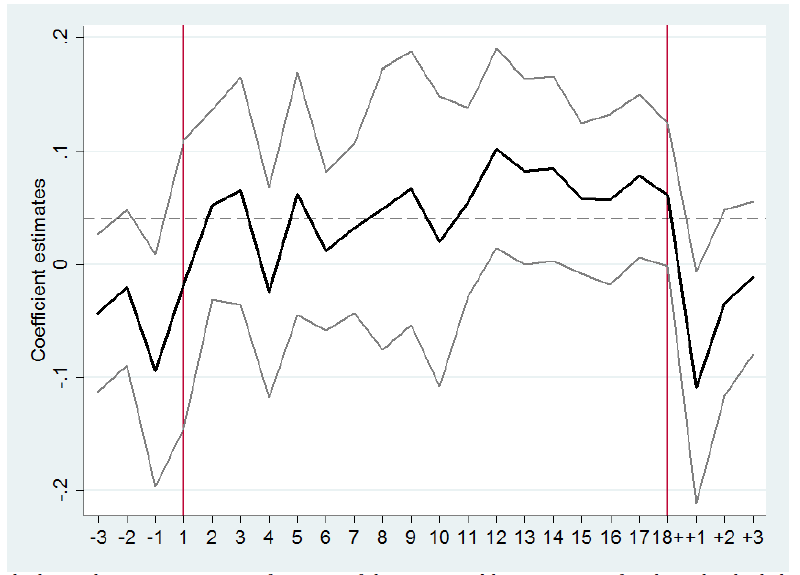In their BSE Working Paper (No. 901),“Access to Power, Political Institutions and Ethnic Favoritism,” Hannes Mueller and Augustin Tapsoba contribute to the literature on ethnic conflict studying the relationship between political power, institutions and ethnic favoritism. They find that ethnic groups which hold executive power at the country level benefit economically. But this effect is dampened or vanishes in environments with strong institutional constraints on the executive. The finding suggests that institutional checks and balances could play a role in preventing violent conflict by restricting favoritism.
Ethnic favoritism in the absence of institutional constraints is a determinant of ethnic conflict
Violent conflict in developing countries is a key policy issue. According to the World Bank, two billion people now live in countries where development outcomes are affected by fragility, conflict, and violence (FCV). In Europe, the issue has received considerable attention due to the refugee crisis. Fighting the root causes of fragility, conflict and violence has taken central stage.
When thinking about reducing conflicts it is of great importance to find their causes and understand their nature. Indeed, there is an extensive literature in economics and political science that point towards ethnic conflict as a main reason for violence. The study of how to reduce ethnic conflict is therefore relevant issue for economic development.
State capture is a central issue, which has received a lot of attention recently. In many countries, different ethnic groups treat the political control of the state as a price to be won. This view, when it is not mediated by an appropriate legislation, leads to a concentration of public goods in the hand of those in power results, which, in turn, can spark violent conflicts. Mueller and Tapsoba share the common view that a more appropriate allocation of public investments would result in more equal economic growth and higher life expectancy in those countries where the need to provide basic standards of living is dramatic.
Which facts they are questioning, and how?
The main question that the study wants to address is whether executive power translates into economic favoritism. Also, it explains how benefits vary according to concentration of power, and how institutional constraints play a role in mediating welfare diminishing practices.
Relying on the Unified Platform for Geographical Research on War (GROWUP), which merges and updates data on Ethnic Power Relations (EPR) with data on light night emissions (NOAA-NGDC, 2013), The authors study the link between per capita night light emission (which proxies for economic benefits) and political power. Their sample includes observations for 564 ethnic groups in 130 countries over the years 1992-2010.
The identification strategy is to exploit changes in political power and light per capita emissions, controlling for country/year fixed effects and ethnic group fixed effects. To get a measure of how political power and ethnic favoritism vary together, Mueller and Tapsoba use an index, which captures the degree to which an ethnic group has access to executive power on a scale from 1 (discriminated against) to 7 (monopoly of power). This allows them to study different degrees of political power: access to the executive power (extensive margin) and the concentration of executive power (intensive margin). In addition, they study the downside of concentration by looking at groups, which are excluded or discriminated against.
As an example, the table below shows the index of executive power for the ethnic minorities in Kenya over the time-span 1963-2013. The ethnic group of the leader is marked by the blue shade in every period.

In this example, the study would exploit the two changes of political power in 1978/1979 and 2002/2003 and ask the question whether light emissions changed systematically when access to political power changed. The following table shows the changes in the value of political power index across time. The labels at the top and on the left column stand for the seven values that the index takes.

Their findings are closely aligned with other studies. There is a significant and quite abrupt change in which light per capita is distributed in a country when the access to political power changes. In quantitative terms, light consumption per capita increases by 6.6 percent compared to the average group when an ethnicity starts to control executive power. In addition, this effect is proportional to the degree of control over political power (13.5 percent for monopolies, 8.4 for dominant groups, 5.4 for senior partners). Groups with limited or with no access to executive power obtain, in percentage terms, substantially less benefits than the average ethnicity (4.9 junior groups, 12.8 discriminated groups).
To rule out the case of having omitted variable or reverse causality bias, several robustness checks are conducted. It is worth mentioning the test for endogeneity between executive power and economic benefits. This issue could arise because groups might gain power as they become economically powerful, and vice versa. What one would expect, if this was the case is that light emissions have a positive trend before political power changes, and a negative trend after losing power. The next figure illustrates the dynamics of executive power before, after and during the period of leadership, which is delimited by the red lines. It is clear from this that there are no positive pre-trends in benefits before gaining power and no negative trends after losing power. However, what is visible is a slight positive trend when in power. This is realistic if powerful groups keep redistributing public resources towards themselves.

As a second step the authors look at the role of institutional constraints. Using data from the Polity IV dataset, the model also incorporates an index that distinguishes between strong and weak institutional constraints (e.g. accountability groups, independent judiciary, ruling party in one party states). This dummy is interacted with the index of political power. The hypothesis here is that with checks and balances executive power might translate into less redistribution towards the powerful group. The authors find strong evidence for this. In fact, most effects of political power completely disappear in countries with strong executive constraints. In other words, powerful groups do not seem to be able to capture the state and redistribute resources towards themselves.
What can we learn?
In accordance to the existing literature, Mueller and Tapsoba show that political power has economic benefits for the leading ethnicity. Also, they argue that this attitude might hinder economic growth, since public resources are not directed toward public investment, but instead are drained by state-level local consumption. In addition, even though economic benefits vary proportionally to the extent of executive power, data support the fact that the presence of institutional constraints has drastic impact on favoritism for any level of political concentration.
In economics, we usually represent the availability and the concentration of wealth with the example of cutting a pie: its size represents abundance of resources; how it is cut into slices reflects distributional patterns. Developing countries which are well-endowed with primary resources that are essential inputs of the industrial process can be regarded, according to our metaphor, as big cakes. When the available wealth is contestable without a set of rule imposing a fair playing field, the biggest slice is eaten by those lucky ones who are in the right circumstances at this right moment, leaving just crumbs to the other guests who have to struggle to feed equal distribution of resources. This last finding might provide a powerful tool in the hand of democratic institution planners. It might also be useful in situations after ethnic conflict where the distribution of state resources is often an important reason for the conflict. Moreover, the question of finding which institutional features are better in preventing favoritism and how they can do it opens the door for future research.


